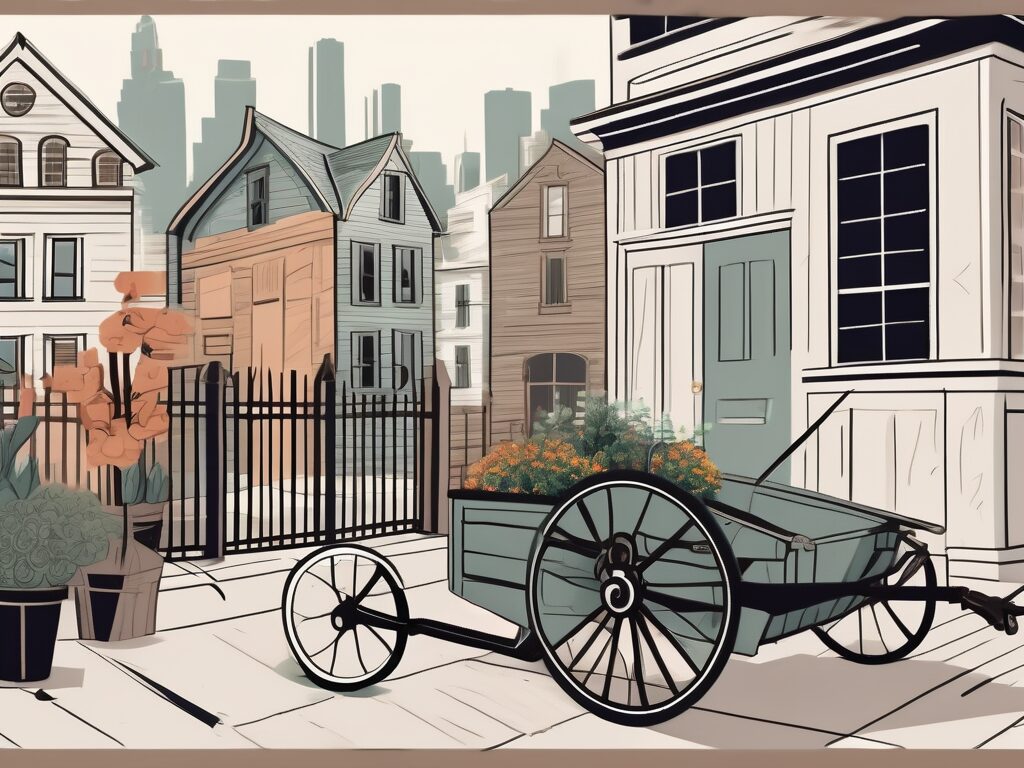
Agent A-Team or Solo Superhero? Finding the Right Real Estate Partner for Your Selling Journey in Wildwood Florida
When it comes to selling your home in Wildwood, Florida,…
January 29, 2024
Carriage houses have a long and storied history, serving a variety of purposes throughout the decades. These unique structures have evolved from their original function to become a versatile and sought-after addition to modern properties. In this article, we will delve into the rich history of carriage houses, explore their key features, discuss their repurposing in the modern era, provide tips for building your own contemporary carriage house, and help you decide if a carriage house is the right choice for you.
Carriage houses, also known as coach houses, first emerged in Europe during the medieval period. They were initially built to house horse-drawn carriages and related equipment. These detached structures were typically located behind larger mansions, providing a secure and convenient place to store carriages and their accompanying horses.
During the medieval period, horse-drawn carriages were the primary mode of transportation for the wealthy. Carriages were not only a means of getting from one place to another, but they were also a symbol of status and wealth. As carriages became more elaborate and expensive, the need for dedicated storage space became apparent. Carriage houses were designed to protect these valuable possessions from the elements and potential theft.
Over time, the design and purpose of carriage houses evolved, reflecting changes in transportation and societal needs. As the popularity of automobiles grew, carriage houses were adapted to accommodate these modern vehicles, solidifying their position as important ancillary structures on residential properties.
With the advent of the automobile, carriage houses underwent significant transformations. They were modified to include larger doors and wider spaces to accommodate the size of cars. Additionally, features such as ramps and lifts were added to facilitate the movement of vehicles in and out of the carriage house.
Carriage houses served more than just a storage function. They often featured living quarters for chauffeurs or other household staff, allowing them to be in close proximity to their employers while still maintaining a level of privacy. This arrangement enhanced the smooth operation of households, with staff readily available to tend to the needs of the residents and their carriages at all times.
Living quarters in carriage houses were designed to provide basic amenities for the staff, including bedrooms, kitchens, and bathrooms. This allowed the staff to live comfortably and conveniently, ensuring that they were always available to attend to their duties. The close proximity of the staff also facilitated communication and coordination between the residents and their staff.
In addition, carriage houses frequently included stables and workshops, making them a hub of activity. The stables provided a safe and comfortable environment for the horses, with space for feeding, grooming, and exercise. The workshops, on the other hand, were equipped with tools and equipment for the maintenance and repair of carriages and automobiles.
The integration of living, working, and storage space in carriage houses created a harmonious and efficient environment, making them essential components of upscale estates. The close proximity of all these functions allowed for seamless operations and streamlined maintenance.
Their strategic location behind the main residence also provided an aesthetic benefit, as they shielded the less glamorous aspects of carriage maintenance from view, presenting a pristine facade to visitors. The carriage houses were often designed to complement the architectural style of the main residence, creating a cohesive and visually appealing estate.
Today, while the need for carriage houses has diminished with the decline of horse-drawn carriages and the prevalence of garages, they still hold a special place in architectural history. Many carriage houses have been repurposed into guest houses, studios, or additional living space, preserving their historical significance while adapting to modern needs.
Carriage houses are characterized by their distinctive architecture, which often includes elements such as gambrel roofs, large double doors, and cupolas. These design features pay homage to their historical roots while adding a touch of charm and nostalgia to contemporary properties.
Gambrel roofs, with their two slopes on each side, are a defining characteristic of traditional carriage houses. This architectural choice not only creates a visually appealing silhouette but also maximizes interior space, allowing for more flexibility in layout and usage.
Large double doors, typically centered on the front facade, serve both a functional and aesthetic purpose. They allow for easy access and maneuverability of carriages or vehicles, while also serving as a focal point for the structure.
Cupolas, small domed structures typically located on the roof, add an elegant touch to carriage houses. These decorative elements not only enhance the architectural integrity of the building but can also provide additional ventilation and natural light to the interior.
Carriage houses have a rich history that dates back to the 18th and 19th centuries. Originally built to house horse-drawn carriages and related equipment, these structures were often separate from the main residence, providing privacy and convenience. Today, carriage houses have evolved to serve a variety of purposes, from guest houses and home offices to art studios and entertainment spaces.
While the exterior architectural elements of carriage houses may remain consistent, the interior design can vary greatly depending on personal preferences and usage. Let’s explore some interior design ideas for carriage houses.
The interior of a carriage house offers numerous possibilities for customization and personalization. Whether you choose to embrace the historical charm or go for a more contemporary aesthetic, it’s important to create a space that aligns with your preferences and needs.
One popular design trend for carriage house interiors is to preserve and showcase the original features and materials, such as exposed wooden beams or vintage brick walls. This approach adds character and authenticity to the space while connecting it to its rich past.
Alternatively, you can opt for a modern and minimalist design, utilizing sleek finishes and clean lines. This approach creates a contrast between the historic exterior and a more contemporary interior, providing a unique blend of old and new.
No matter the design direction you choose, it’s important to prioritize functionality. Carriage houses often have limited square footage, so it’s essential to consider space-saving solutions and flexible furniture arrangements to make the most of the available area.
Incorporating clever storage solutions, such as built-in shelving or hidden compartments, can help maximize space and keep the carriage house organized. Additionally, utilizing multi-purpose furniture, such as convertible sofas or fold-out desks, can provide versatility without sacrificing style.
Lighting is another crucial aspect of carriage house interior design. Consider incorporating a mix of natural light, through strategically placed windows or skylights, and artificial lighting, such as pendant lights or track lighting, to create a warm and inviting atmosphere.
Lastly, don’t forget to add personal touches and decorative elements that reflect your individual style. Whether it’s artwork, family photographs, or unique vintage finds, these details can make the space feel truly personalized and inviting.
The size of a carriage house can vary significantly depending on your needs and property limitations. When determining the ideal size, it’s essential to consider both functionality and aesthetics.
If you plan to use your carriage house primarily for vehicle storage, it’s crucial to ensure that it can comfortably accommodate your vehicles. Measure the dimensions of your largest car or other equipment to determine the minimum size requirement.
Additionally, consider whether you would like to incorporate living or working space into your carriage house. Factoring in these needs will help determine the appropriate square footage and layout to achieve a balanced and efficient use of the space.
Carriage houses can also serve as a guest house or rental property, providing an additional source of income. In such cases, it’s important to consider the number of bedrooms, bathrooms, and living areas required to meet the needs of potential occupants.
Of course, local zoning regulations and property restrictions may also influence the size of your carriage house. It’s important to consult with professionals and local authorities to ensure compliance with any regulations or restrictions.
When designing the layout of your carriage house, consider the flow of the space and how different areas will be utilized. Creating separate zones for living, working, and storage can help maximize functionality and create a harmonious living environment.
Remember, the ideal size for a carriage house is subjective and will depend on your specific requirements and preferences. Taking the time to carefully plan and consider all aspects will help ensure that your carriage house meets your needs and exceeds your expectations.
In recent years, repurposing carriage houses has become increasingly popular as a way to enhance property value and provide additional living or working space. Converting a carriage house into a guest cottage, home office, or rental unit can significantly increase the overall value of your property.
By cleverly transforming this once-utilitarian structure into a functional and attractive living space, you can tap into the growing demand for unique and character-filled accommodations. Guests or tenants seeking a distinctive experience will appreciate the historical significance and charm of a converted carriage house, making it a lucrative investment.
When renovating a carriage house for conversion, it’s important to strike a balance between preserving the original character and incorporating modern amenities. Thoughtful design choices that blend old and new will ensure that the space remains appealing and functional for years to come.
If you have an existing carriage house on your property or are willing to build one, it can serve as an excellent source of additional income. The rise of vacation rental platforms, combined with the enduring appeal of unique accommodations, has created a significant demand for carriage house rentals.
Carriage houses, with their historical charm and self-contained nature, provide an ideal setting for short-term rentals. These rentals offer guests a level of privacy and independence that is often lacking in traditional accommodations, making them highly sought after.
Renting out a carriage house can provide a steady stream of income, offsetting the cost of maintenance and potentially even turning a profit. However, it’s important to thoroughly research local regulations and licensing requirements before embarking on this venture.
If you’re considering building a carriage house from scratch, it’s essential to approach the process with careful planning and attention to detail. Follow these essential steps to ensure a successful construction project:
When designing a contemporary carriage house, it’s important to strike a balance between functionality and aesthetics. Consider the following design aspects to create a space that fulfills your needs and reflects your personal style:
Investing in a carriage house is a significant decision that requires careful consideration. Before embarking on this endeavor, take the following factors into account:
A carriage house can be a valuable addition to your property, but it’s essential to assess your lifestyle and needs to determine if it aligns with your goals. Ask yourself the following questions:
By honestly assessing your lifestyle, needs, and goals, you will be better equipped to determine if a carriage house is the right choice for you.
In conclusion, discovering the rich history and versatile uses of carriage houses reveals their significance as architectural gems with boundless potential. From their origins as carriages’ shelter to the modern era’s repurposing, these structures continue to captivate homeowners and investors alike. Whether you choose to build a contemporary carriage house or refurbish an existing one, the unique charm and functionality they offer make them a worthwhile addition to any property. Take the time to evaluate your needs, research local regulations, and engage with professionals to embark on this exciting journey of incorporating a carriage house into your life and property.

If you want the Richr team to help you save thousands on your home just book a call.
 Book a call
Book a call